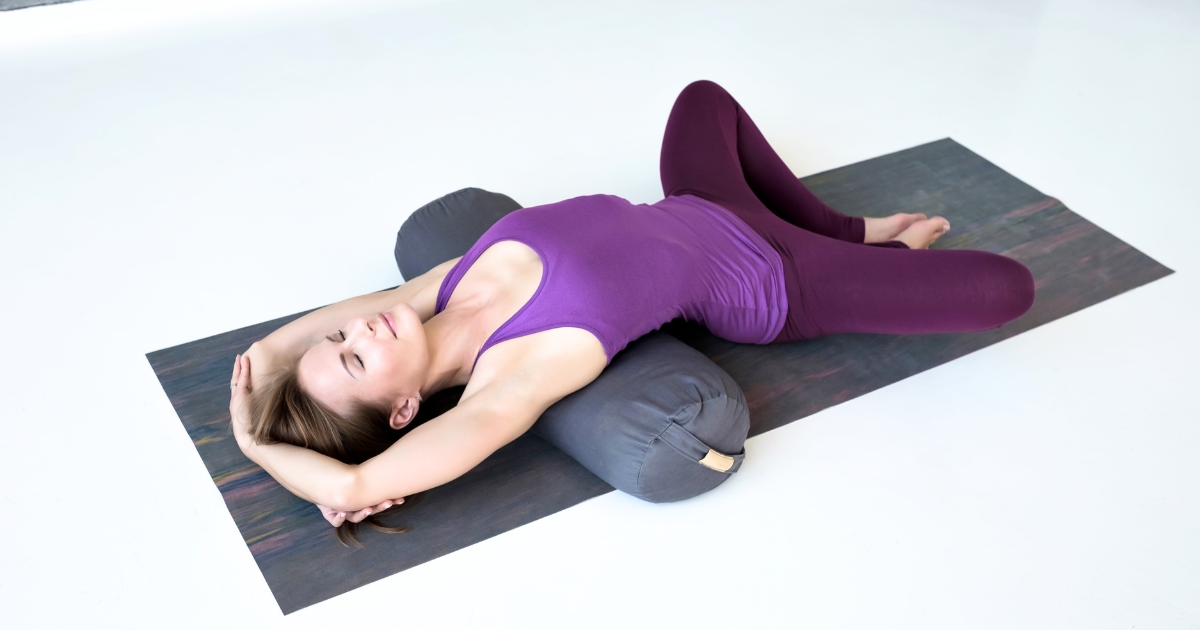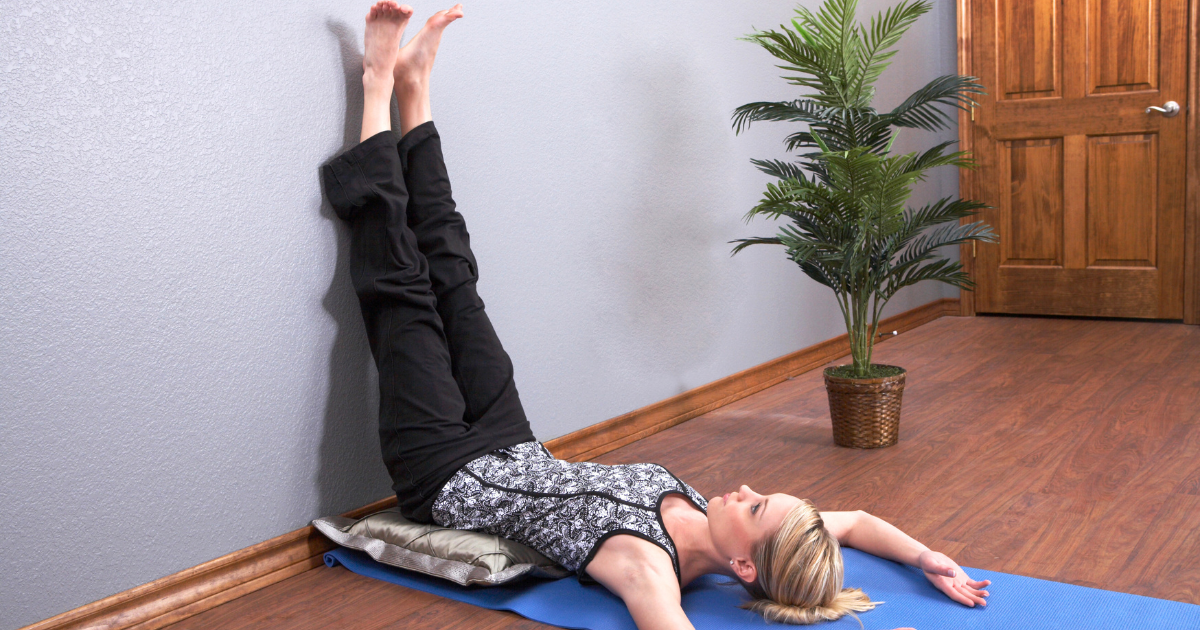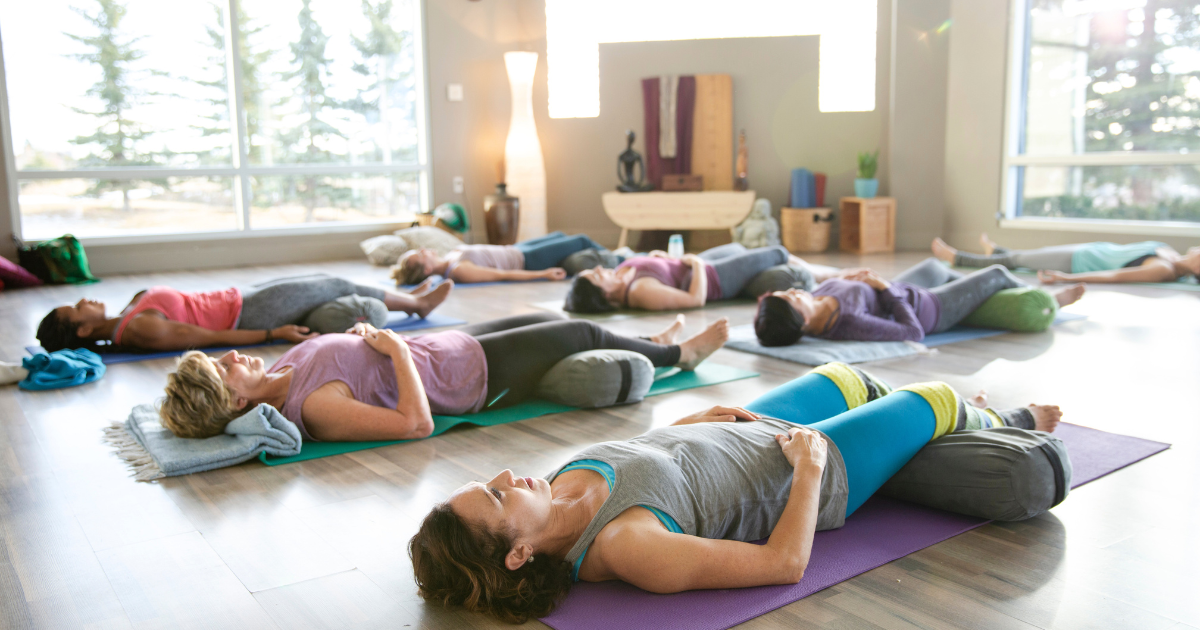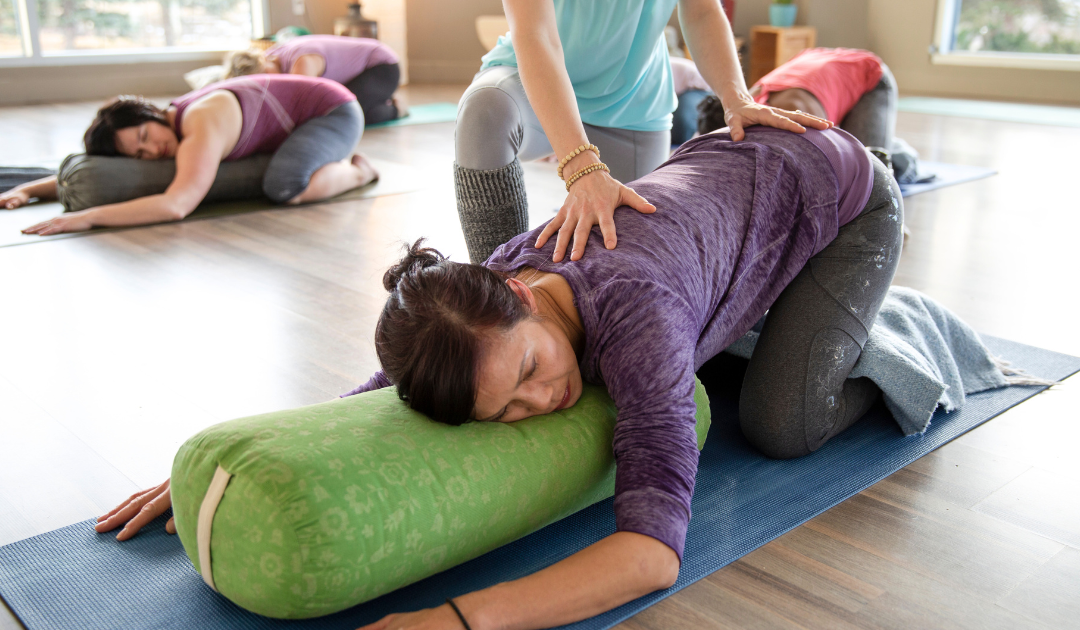Child’s Pose (Balasana):

Instructions:
- Start by kneeling on the floor, with your big toes touching and knees slightly wider apart. Put a bolster or pillow in front of you.
- Sit back on your heels and slowly fold your torso forward, resting it on the bolster between your thighs.
- Rest your arms along the mat or place them alongside your body.
- Turn your head to one side. Close your eyes, relax your shoulders, and breathe deeply and hold the pose for 3-5 minutes.
- You can turn your head to the other side and stay there for a few minutes.
Benefits:
- Relieves tension in the back, neck, and shoulders.
- Calms the mind and promotes relaxation.
- Stretches the hips, thighs, and ankles.
- Eases digestion and relieves stress.
Modifications:
- If you have difficulty sitting on your heels, place a blanket or bolster between your buttocks and heels.
- For extra support, put a folded blanket under your forehead.
Supported Reclining Bound Angle Pose (Supta Baddha Konasana):

Instructions:
- Place a bolster or a stack of folded blankets horizontally behind you.
- Sit on the floor with your knees bent and the soles of your feet together.
- Slowly lie back, ensuring that the bolster supports your entire spine.
- Allow your knees to open out to the sides, creating a diamond shape with your legs.
- Rest your arms on the floor, palms facing up, or take your arms up over your head and hold your opposite elbows.
- Close your eyes and relax your body, focusing on deep, even breaths.
- Stay in this pose for 10-15 minutes, allowing your body to release tension and open up.
Benefits:
- Opens the hips and stretches the inner thighs.
- Relieves tension in the lower back and promotes relaxation.
- Calms the mind and reduces stress and anxiety.
- Aids digestion and improves blood circulation.
Modifications:
- If the knees don’t comfortably reach the ground, place folded blankets or blocks underneath them.
- For additional support, place a folded blanket or bolster under the length of your spine.
See also : Mindfulness Meditation: An Easy way to Cope with Stress and Anxiety
Legs-Up-The-Wall Pose (Viparita Karani):

Instructions:
- Find an open wall space and place a pillow or a folded blanket. Sit sideways with your right hip touching the wall.
- Slowly lower your back to the floor while simultaneously lifting your legs up against the wall.
- Allow your arms to rest by your sides,palms facing up.
- Relax your entire body, close your eyes, and let gravity do the work.
- Stay in this pose for 10-15 minutes, focusing on slow and deep breaths.
Benefits:
- Relieves tired and swollen legs and feet.
- Reduces lower back pain and improves circulation.
- Calms the nervous system and reduces anxiety.
- Promotes relaxation, better sleep, and relief from insomnia.
Modifications:
- If you have tight hamstrings, place a folded blanket or bolster under your hips for added support.
- If neck strain is a concern, use a folded blanket or neck pillow to support the cervical spine.
Corpse Pose (Shavasana)

Instructions:
- Lie down on your back with your arms relaxed by your sides and legs extended.
- Place a bolster or folded blanket under your knees and another one under your head.
- Allow your body to sink into the support of the props, releasing muscular tension.
- Soften your face and close your eyes, focusing on deep, slow breaths.
- Remain in this pose for 10-15 minutes, allowing your body and mind to completely relax.
Benefits:
- Relaxes the entire body and mind deeply.
- Reduces anxiety, stress, and fatigue.
- Soothes the nervous system and improves focus.
- Aids in rejuvenation, better sleep, and reduced insomnia.
Modifications:
- If the bolster is too high, use additional blankets or a lower prop.
- If you experience lower back discomfort, place a folded blanket or bolster under your lower back.
Seated Forward Fold ( Paschimottanasa)

Instructions:
- Sit on your yoga mat with your legs extended straight in front of you. Put a bolster on your legs.
- Engage your spine and ground your sitting bones. Make sure you’re not collapsing your lower back.
- If it’s difficult to keep your spine straight, sit on a folded blanket or cushion to elevate your hips.
- Take a deep inhale to lengthen your spine. As you exhale, gently begin to hinge forward at the hips, leading with your chest.
- Bring your torso down towards the bolster, allowing it to support your upper body. You can rest your forehead on the bolster or place your arms alongside your body on the mat.
- Close your eyes and take deep breaths, allowing your body to relax into the pose.
- Hold the pose for 5 to 10 breaths, or longer if it feels comfortable. Focus on the sensations in your hamstrings and back.
Benefits
- Stretches the hamstrings and spine, relieving stress and improving digestion
Modifications
- Use a strap for reach, bending the knees for comfort, or elevating the hips with a bolster or blanket for better alignment.
Bolster Twist

Instructions
- Put a bolster lengthwise on a yoga mat. Sit sideways on your mat with your hips a few inches away from the end of the bolster.
- Now turn toward the bolster and place your hands on either sid eof the bolster and slowlly lower your torso down on tot he bolster. You can make adjustments according to your comfort.
- Turn your head in the direction of the twist.
- Take a few breaths here and rest for atleast 5 minutes.
Benefits
- Enhances spinal mobility, relieves tension, and promotes circulation
Modifications
- Adjust the bolster height, place a pillow under the knees for support, or practice a gentler twist to avoid strain.
Takeaway
Incorporating restorative yoga poses into your daily routine can profoundly enhance your mental and physical well-being. These wonderful restorative yoga poses offer a sanctuary for relaxation and mindfulness. By fostering a deeper connection with your breath and body, these practices help reduce stress, alleviate tension, and promote a sense of inner peace. Whether you’re seeking to unwind after a hectic day or looking to cultivate a greater sense of calm, embracing restorative yoga can be a transformative journey towards holistic wellness and balance in your life.


